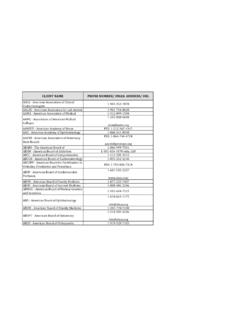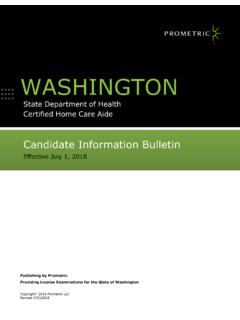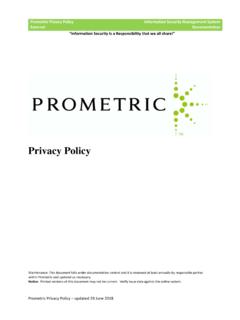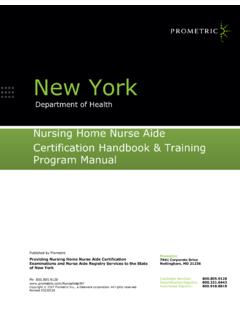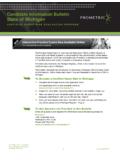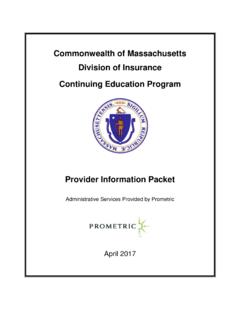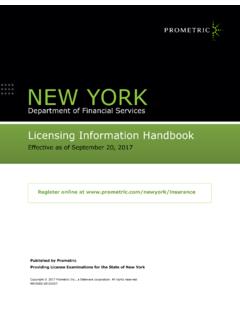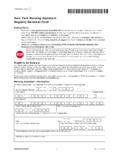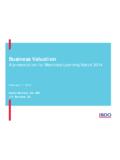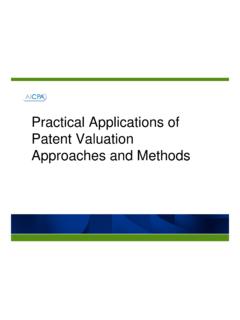Transcription of Examination Content Outline - Prometric
1 1 Examination Content Outline The following Outline is a list of topics for each part of the Examination . Not every topic on the list will necessarily appear on the Examination and the list should not be viewed as all-inclusive. Some topics may appear in more than one Examination part. This list is also available at Part 2 - Businesses 1. Business Entities 28 Questions Business Entities and considerations - Sole proprietorships - Partnerships and qualified joint ventures (QJV) - Corporations - S corporations - Farmers - LLCs - Tax-exempt entities and associations - Entity type default classifications and elections - Employer identification number - Accounting periods (tax year) - Accounting methods - Reporting requirements ( Forms W-2, W-4, Form 1099) - Hobby versus business determination and loss limitations Partnerships - Partnership income, expenses, distributions, and flow-through ( , self-employment income) - Family partnerships - Partner's dealings with partnership ( , exchange of property, guaranteed payments) - Contribution of property to partnership ( , partnership's basis, property subject to indebtedness) - Basis of partner's interest - Disposition of partner's interest - Partnership formation ( , partnership agreement, general vs.)
2 Limited partners, capital contributions) - Dissolution of partnership ( , sale, death of partner) - Filing requirements, due dates, and penalties - Services rendered in return for partnership interest - Debt discharge Corporations in general - Filing requirements, due dates, and penalties - Earnings and profits - Shareholder dividends, distributions, and recognition requirements - Special deductions and credits ( , dividends received deductions, charitable deduction) - Liquidations and stock redemptions - Accumulated earnings tax - Estimated tax payments - Alternative minimum tax and Alternative Tax Net Operating Loss (ATNOL) Forming a corporation - Services rendered to a corporation in return for stock - IRC section 351 exchange - Transfer and/or receipt of money or property in addition to corporate stock - Transfer of property subject to indebtedness - Controlled groups - Closely held corporations - Personal service corporations S corporations - Requirements to qualify ( , qualifying shareholders) - Election procedure - Income, expenses and separately stated items - Treatment of distributions - Shareholder s basis ( , loan basis, distributions and losses in excess of basis) - Revocation, termination and reinstatement - Debt discharge - Non-cash distributions 2.
3 Business Financial Information 39 Questions Business Income - Gross receipts and other income - Cost of goods sold ( , inventory practices, expenditures included, uniform capitalization rules) - Net income, net operating losses, and loss limitations including passive activity and at risk limitations - Gain or loss on disposition of depreciable property - Cancellation of business debt Business expenses, deductions and credits - Officers and Employees compensation ( , deductibility, fringe benefits, rules of family employment, statutory employee, necessary and reasonable) - Business rental deduction, including self-rentals 2 - depreciation , amortization , IRC section 179, and depletion and correcting errors - Business bad debts - Business travel, entertainment, and gift expenses - Interest expense - Insurance expense - Taxes ( , deductibility of taxes, assessments, and penalties; proper treatment of sales taxes paid) - Employment taxes - Federal excise tax - Casualties, thefts, and condemnations - IRC section 199 deduction (domestic production activities) - Eligibility and deductibility of general business credits ( , disabled access credit, investment credit, small business healthcare tax credit) - Net operating loss deduction - Home office Business assets - Basis of assets - Disposition of depreciable property - Like kind exchange - Converted property - Capitalization and repair regulations ( , elections) Analysis of financial records - Proper business type, and the use of classification codes - Income statement - Balance sheet ( , proofing beginning and ending balances) - Method of accounting and changes ( , accrual, cash, hybrid, Form 3115) - depreciation , depletion, and amortization ( , start-up and organizational cost) - depreciation recovery ( , recapture, IRS sec 280F)
4 - Pass-through activity ( , K-1, separately stated items, non-deductible expenses) - Reconciliation of tax versus books ( , M-1, M-2, M-3) - Related party activity - Loans to and from owners Advising the business taxpayer - Filing obligations ( , extended returns and potential penalties) - Deposit obligations ( , employment tax, excise tax) - Reporting obligations for businesses ( , Form 1099 series, IRC code 1031 exchanges, Form 8300) - Record-keeping requirements ( , mileage log, accountable plans) - Related party transactions - Selection of business entity ( , benefits and detriments) - Comingling ( , personal usage of business accounts, separation of business and personal accounts) - Advice on accounting methods and procedures ( , explanation of requirements) - Transfer elections in or out of the business ( , contributed property, distributions) - Life cycle of the business ( , formation, dissolution) - Type of industry ( , personal service corporation) - Worker classification ( independent contractor versus employee) - Deductions and credits for tax planning ( , timing of income and expenses, NOL, depreciation versus IRC section 179) - ACA compliance 3.
5 Specialized Returns and Taxpayers - 18 Questions Trust and estate income tax - Trust types ( , simple/complex, grantor, irrevocable, tax shelters, foreign) - Distributable net income and accounting income - Exclusions, exemptions, and deductions - Fraudulent trusts - Income in respect of a decedent - Income ( , allocations, corpus versus income) - Separately stated items - Filing requirements, tax years, and penalties Exempt organizations - Qualifying for and maintaining tax-exempt status ( , IRC 501(c)) - Applying for IRS tax-exempt status ( , Form 1023, Form 1024) - Filing requirements ( , Form 990 series) - Unrelated business taxable income Retirement plans - Employer and employee contributions - Reporting requirements - Plans for self-employed persons ( , SEP and SIMPLE) - Prohibited transactions - Qualified and non-qualified plans - Non-discrimination rules Farmers - Farm income ( , self-raised livestock, crop insurance proceeds, subsidies, patronage dividends, conservation payments) - Farm inventory - depreciation for farmers - Various disaster-area provisions - Disposition of farm assets - Farm rental - Farm tax computation ( , Schedule J, Schedule SE, estimated tax)

